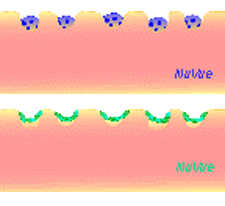I first became interested in bones as a young dancer (about 200,000 years ago, in the Mid Paleolithic era). I was studying body alignment and I became fascinated with the skeleton and the remarkable living tissue that makes up our bones. I was intrigued by the intricate architectural structure of bone.
 There’s the smooth, hard shell we see on the outside called cortical bone, and the amazing crisscrossed, honeycomb like structure on the inside called trabecular bone. The combination of cortical and trabecular bone make our skeletons, strong, light, flexible and efficient.
There’s the smooth, hard shell we see on the outside called cortical bone, and the amazing crisscrossed, honeycomb like structure on the inside called trabecular bone. The combination of cortical and trabecular bone make our skeletons, strong, light, flexible and efficient.
The structure of trabecular bone is the secret ingredient. The trabecular bracing structure is located at precisely the correct angles to absorb the maximum force.
So when you jump over a puddle or run for a bus, it’s the trabecular bracing that directs the force to the strongest part of your skeleton and prevents a bone from breaking.
Most of us aren’t aware of our beautiful bone structure. But, it hasn’t gone unnoticed or unutilized.
The structure of trabecular bone was copied by the French bridge builder Gustave Eiffel, who wanted to build the tallest man-made structure in the world. When he built the Eiffel tower in 1889, he calculated the positioning of the braces in the curves of the legs to direct any force like high winds on the entire structure to the strongest area; the four legs. This is why the Eiffel tower continues to stand the test of time.
 That’s fine for an iron tower. If part of it becomes weakened you can see it and fix it. But what happens to weakened or damaged areas of our skeletons?
That’s fine for an iron tower. If part of it becomes weakened you can see it and fix it. But what happens to weakened or damaged areas of our skeletons?
I was astonished to find out that bones are pretty smart. They don’t grow to adult size and then stop.
Our skeletons are constantly getting rid of old weakened bone tissue and replacing it with new healthy bone. In a process called remodeling, old weakened areas are broken down and replaced with new well-formed tissue. Our bodies replace about 10 percent of our bone each year.
 In bones with osteoporosis, the remodeling process has gotten out of whack. Those sturdy crisscrossed structures disappear and bones get weak and start to fracture. Fractures occur most often where there is the most trabecular bone.
In bones with osteoporosis, the remodeling process has gotten out of whack. Those sturdy crisscrossed structures disappear and bones get weak and start to fracture. Fractures occur most often where there is the most trabecular bone.
The three areas most at risk for osteoporotic fracture are the spine has the most trabecular bone. So, if you have osteoporosis, the vertebrae start to squash under the weight of the torso. The thighbone at the hip is next. It can break just stepping off a curb. And the wrist will likely break if you put out your hands to catch yourself in a fall.
But there’s a lot you can do to prevent osteoporosis and maintain bone health. Weight bearing exercise like walking, jogging, aerobic dance and weight resistance training, stimulate the remodeling process and promote bone growth.
Exercise should be site specific. Do weight bearing and resistance exercises for the whole body but pay special attention to the areas most at risk; the spine, the hip and the wrist.
Calcium and Vitamin D are also important. Here’s a link to the current National Osteoporosis Foundation guidelines.
Remember your bones are living tissue. Take care of them and they’ll take care of you. For more info about osteoporosis and exercise.
Mirabai Holland MFA, EP-C, CHC is one of the foremost authorities is the health and fitness industry. Her customer top rated exercise videos for Age-Onset health issues like Osteoporosis, Arthritis, Heart Disease, Diabetes & more are available at www.mirabaiholland.com. Mirabai also offers one-on-on Health Coaching on Skype or Phone. Contact her at askmirabai@movingfree.com
